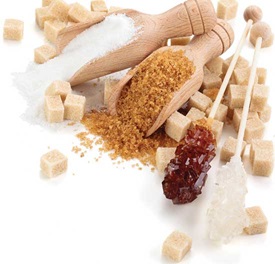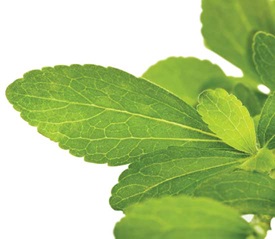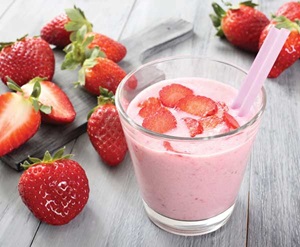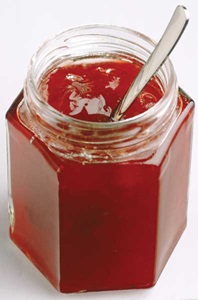The Rush to Reduce Sugar
INGREDIENTS
 Eat less sugar. That’s what consumers have heard for years. Consuming less sugar can be a challenge though. Sugar plays several functional roles in food and beverage applications, and often turns up in unexpected products (so-called “hidden sugars”). Our brains are preprogramed to enjoy sweet taste. And let’s face it, sweet foods are delicious.
Eat less sugar. That’s what consumers have heard for years. Consuming less sugar can be a challenge though. Sugar plays several functional roles in food and beverage applications, and often turns up in unexpected products (so-called “hidden sugars”). Our brains are preprogramed to enjoy sweet taste. And let’s face it, sweet foods are delicious.
Recently, there has been a concerted push to limit sugar intake, due in part to research investigating the overconsumption of sugar and the potential development of certain diseases and health problems. With all the recent calls for sugar reduction—be they the mandate to list added sugars on the Nutrition Facts panel, dietary guidelines that suggest people consume less sugar, and the National Confectioners Association’s Always A Treat initiative to provide portion guidance, innovative products, and packaging options to help consumers manage sugar intake—manufacturers are moving quickly to reformulate food and beverage products. The thing is, reducing or removing an ingredient in a formulation, especially one with so many essential functions like sugar, is often a challenge.
“There is no single ingredient which could replace sucrose, and each type of application has different challenges because sucrose has many physical properties beyond taste,” says Tomokazu Okazaki, R&D director of applications at Matsutani Chemical Industry. “For example, replacing sugar by adding other sweeteners to baked goods may result in less volume and less color from the original recipe. Sugar replacement must be considered from different angles all the time.”
Product developers must understand all the roles that sugar plays in a specific product to effectively replace it, says Michelle Schwenk, group director, carbohydrate and wellness, at ADM. “Some sugars, like fructose, are a good humectant, and so you would need to replace that humectancy. Sometimes sugar is just used for sweetness, so replacing the full sweetness profile would be important. Sometimes sugar creates viscosity, binds water, or provides bulk. In high solids, or high sugar systems, some of this functionality is unique to sugars and difficult to replace.” To this end, the scientists at ADM investigate the structure and function of the carbohydrate in the system to understand the functionalities and use their expertise in flavors to analyze sweetening and flavor profiles all to better recommend the best systems for sugar reduction and replacement, says Schwenk.
Blending different sweeteners is an approach that ingredient manufacturers take to address specific functions such as sweetness onset, humectancy, and texture. “Blends can help manufacturers get to market faster with tried and tested versions designed to deliver the right balance of sweetness, calories, nutrition, and cost,” says Rod Schanefelt, director of sugar and high potency sweeteners at ADM.
Some sweetener manufacturers formulate a stevia ingredient by blending different steviol glycosides or use different types of sweeteners together in a formulation. For example, Thom King, president and CEO of Icon Foods, works with various steviol glycosides to develop sweeteners that have optimal tastes and sweetness qualities. “When you use Reb M and Reb D in tandem with Reb A there is some interesting masking that goes on and blocks off-notes very effectively,” he says. “Additionally, I am working with enzymatically treated steviol glycosides, and the results are impressive. Combining a variety of steviol glycosides garners a variety of results, and bringing in mogrosides, which occur in monk fruit, really ups the ante.” ADM, on the other hand, draws on its knowledge of product development, applications, culinary, flavor creation, and sensory science to create sweetener solutions that work synergistically with a product’s flavor, color, texture, nutrition, and shelf-life requirements, says Schanefelt.
What Consumers Want in Sweeteners
It takes plenty of research and an understanding of product development and consumer trends to develop sweeteners and choose the best one for specific applications and sugar-reduction targets. “Through our proprietary OutsideVoice consumer-backed research program, we conducted a study with thousands of consumers last year to learn more about their attitudes, usage behaviors, and perceptions towards sugars and sweeteners used in the products they consume most often,” says Mark Rainey, chief marketing officer of ADM. “Consumer behaviors continue to evolve, and through this study we learned, for example, that stevia and monk fruit are currently favored among ‘naturalists’ and ‘moderationists’, although monk fruit is not as well-known as stevia. We’ve also identified different attitudes, perceptions, and needs regarding sweeteners in their packaged foods, and these can vary by eating or drinking occasion.”
ADM’s research also examines sweetening from sensory and organoleptic perspectives. “Through extensive analytical testing, including use of our trained descriptive sensory panel, we’ve developed a multidimensional technical understanding, including flavor and taste fingerprints across a wide range of sweeteners using modern techniques and approaches to help us design custom blends and systems that can help developers save valuable time to market and optimize their formulations for maximum consumer preference and to their exacting needs,” explains Rainey.
Like Rainey, other experts point to clean label demands driving the development of certain types of sweeteners. “The interest in clean label will be getting higher, and many consumers are trying to avoid consuming artificial sweeteners because they believe that some zero-calorie sweeteners could lead to health problems,” says Koji Sasaki, R&D manager of snack and baking applications for Matsutani Chemical Industry. “Therefore, sweeteners that have zero calories, a natural image, and some physical functions will be more preferred.” King echoes this sentiment: “We are getting exponentially more requests to reformulate customers’ products and remove aspartame, Ace K, and sucralose. Consumers are demanding less sugar and cleaner labels they can understand. Customers recognize stevia and monk fruit as clean options.”
 Next-Gen Stevia
Next-Gen Stevia
Of all the sweeteners available, stevia has captured the attention of product developers. Since it first became commercially available and authorized for use in foods and beverages, stevia ingredients have transformed from those with lingering bitter or licorice-like aftertaste to those with a clean, sweet taste and very minimal off-taste issues. This is thanks in part to discovery of other steviol glycosides that go beyond the bitter-tasting Reb A glycoside to offer better-tasting sweetening potential. Two of the more widely researched steviol glycosides are Reb M and Reb D, which several ingredients suppliers have commercialized or are about to commercialize.
Before these new Reb M and Reb D sweetener ingredients came to fruition, ingredient manufacturers had to overcome a major hurdle. While the amounts of Reb A naturally present in the stevia leaf are plentiful, the amounts of Reb M and Reb D are miniscule and there currently is not a great enough supply of stevia plants to meet the proposed demand. Ingredient manufacturers turned to different proprietary techniques to produce these steviol glycosides. PureCircle has developed two approaches to producing greater amounts of Reb M and Reb D. First, the company developed a proprietary strain of the stevia plant that has higher amounts (around 20 times more) of the two steviol glycosides than conventional stevia plants. Scientists with the PureCircle Stevia Agronomy Program used traditional cross-breeding techniques to develop the Starleaf stevia plant. The plant is currently growing in locations in the United States, and the company continues to work with farmers to add more acreage. PureCircle also produces Reb M through a process that uses enzymes. The sweet components of the stevia leaf are formed as stevia matures from seedling to full-grown plant, when the leaf produces enzymes that convert Reb A to Reb D and then to Reb M, according to the company. PureCircle takes purified stevia leaf extract with low Reb D and Reb M from conventional stevia leaves and adds enzymes to complete the conversion process, according to the company.
 Cargill offers EverSweet, a blend of Reb M and Reb D produced using a fermentation process. Scientists analyzed the enzymes in the stevia plant that convert simple sugars to the various steviol glycosides. They added genes from the stevia plant and from other plants to a baker’s yeast, enabling the baker’s yeast to produce the type of enzymes used by the stevia plant. The baker’s yeast is then fed a simple carbohydrate source to produce steviol glycosides that are identical in structure and sweetening potential to the Reb M and Reb D found naturally in the stevia plant, according to the company. The remaining yeast is filtered away and the glycosides are purified to produce EverSweet.
Cargill offers EverSweet, a blend of Reb M and Reb D produced using a fermentation process. Scientists analyzed the enzymes in the stevia plant that convert simple sugars to the various steviol glycosides. They added genes from the stevia plant and from other plants to a baker’s yeast, enabling the baker’s yeast to produce the type of enzymes used by the stevia plant. The baker’s yeast is then fed a simple carbohydrate source to produce steviol glycosides that are identical in structure and sweetening potential to the Reb M and Reb D found naturally in the stevia plant, according to the company. The remaining yeast is filtered away and the glycosides are purified to produce EverSweet.
Health-conscious consumers are looking for more low- and no-calorie food and beverage options that still deliver on the sweet taste they are used to. EverSweet is said to deliver on both. Depending on the application and sugar-reduction target, food formulators can develop food and beverage products with reduced calories or zero calories. “We are hearing from customers that it tastes amazing, with a clean, sweet taste; very little linger; and no off-notes,” says Mandy Kennedy, senior marketing manager at Cargill. “Our customers appreciate that EverSweet is a more sustainable way to get to Reb M and D compared with producing them from the stevia leaf. It’s also a consistent product, with a scalable and efficient supply chain.”
Cargill is working with several of its customers, both large and small, on a wide variety of reduced-sugar food and beverage applications, says Kennedy. “In particular, we’re seeing high demand in the beverage, nutrition, and dairy categories. Regardless of the application, customers are turning to our EverSweet next-generation sweetener to achieve deep reductions in sugar levels. In many cases, EverSweet can help customers formulate zero-added-sugar products.”
 Product concepts formulated with EverSweet focus on how the ingredient functions in different beverage types. Cargill featured a spicy Mexican chocolate mocha cold brew and grapefruit basil soda cocktail mixer at the 2018 SupplySide West event and a pear tarragon craft soda and strawberry drinkable yogurt at the IFT18 food expo.
Product concepts formulated with EverSweet focus on how the ingredient functions in different beverage types. Cargill featured a spicy Mexican chocolate mocha cold brew and grapefruit basil soda cocktail mixer at the 2018 SupplySide West event and a pear tarragon craft soda and strawberry drinkable yogurt at the IFT18 food expo.
DSM also uses a fermentation method to produce its new AVANSYA Reb M sweetener. One of the product concepts DSM developed to highlight the ingredient’s sugar-like taste is a sweetened yogurt. The AVANSYA Reb M ingredient allowed for a 100% reduction in added sugar.
Earlier this year, Tate & Lyle introduced several stevia ingredients, giving food formulators even more stevia options to use in reduced-sugar products. It promotes its TASTEVA M Stevia Sweetener, which was introduced at the IFT18 food expo, as having a cleaner, sugar-like taste when used at high sugar-replacement levels compared with Reb A. The ingredient is said to have a sweet onset like sucrose and no bitter linger like Reb A. According to the company, “TASTEVA M starts with the stevia leaf extract and then uses a bio-conversion process and aqueous-only finishing step to produce its Reb M.” A raspberry peach lemonade product concept distributed at the IFT18 food expo had 50 calories per 8-ounce serving, a 75% sugar reduction, and 0 grams of added sugar.
Optimizer Stevia 4.10 and Intesse Stevia 2.0 from Tate & Lyle and Sweet Green Fields made their debut at the IFT18 food expo. Both ingredients are blends of steviol glycosides designed to hit certain levels of sugar reduction and provide clean, sweet taste without lingering bitterness. They function in a variety of food and beverage applications. Intesse Stevia 2.0 is especially suited for use in syrups and in the manufacture of concentrates due to its excellent solubility properties. The ingredient was featured in a mango coconut beverage concept that had 25 calories per 8-ounce serving, an 80% reduction in sugar, and 0 grams of added sugar.
Stevia’s popularity has grown in part because of demands for clean label ingredients. “As an increasing number of consumers seek out better-for-you options that feature lower calories and closer-to-nature or pantry-friendly ingredients, ADM continues to innovate in the Reb M and Reb D category and beyond,” says Schanefelt. “Unique agricultural programs provide us with access to an assortment of high-quality stevia varieties, enabling us to offer the most comprehensive portfolio of stevia ingredients.” ADM developers are focusing on the next generation of stevia sweeteners that will offer more alternatives to food manufacturers and consumers, he adds. “ADM’s stevia varieties offer a higher yield per acre of stevia grown and a higher content of desired sweetening components, resulting in an optimal balance of taste, cost, calories, and label.”
Some of the demands for clean label ingredients come from consumers paying more attention to labels and ingredient lists on food and beverage products. “According to our recent consumer study, 50% of consumers said that recognizing all the ingredients on the product label positively impacts their purchase decision,” says Afrouz Naeini, senior marketing manager—sweetness and beverage, Ingredion. “Forty percent said that seeing naturally based ingredients also positively impacts their purchase decision. A separate study showed us that grams of sugar on the label negatively impacts, on average, 70% of consumers. Furthermore, grams of sugar negatively impacts the purchase decision of 60% of consumers, on average, across different food and beverage categories.”
These two trends of clean label and added sugars have intersected, creating what Naeini says is a stronger pull for naturally based sweeteners like stevia. “Suppliers in turn have focused on expanding their portfolios with naturally based sugar alternatives through stronger focus on innovation. Ingredion’s commercial launch of BESTEVIA Reb M stevia leaf sweetener is one example. The product offers sugar-like taste from leaf-based, stevia leaf Reb M at 95% purity. This product continues to help developers formulate clean label products with up to 100% sugar reduction capabilities with minimal bitter aftertaste to mask.”
Developed with Ingredion’s partner SweeGen, BESTEVIA Reb M stevia leaf sweetener is 200–300 times sweeter than sugar and can reduce sugar by more than 70%. Sensory data depicted on a spider chart shows how close BESTEVIA Reb M and sucrose are in terms of taste. Ingredion developed a black sesame chewy candy bite with the sweetener for the IFT18 food expo. The product concept has 130 calories and 2 grams of sugar per 10 gram serving.
Take Notice of Allulose
Stevia gets plenty of consideration when replacing sugar in formulations, but there is another sweetener ingredient garnering the attention of product developers. Allulose is a monosaccharide isomer of fructose that is found in very small quantities in fruits like raisins and figs and in foods like maple syrup, brown sugar, and caramel sauce. Because it is found naturally in such small amounts, it is referred to as a “rare sugar.” Several ingredient manufacturers of sweeteners specialize in producing allulose. Some of them presented the latest developments regarding the sweetener at the IFT18 food expo this past summer.
Matsutani Chemical Industry Co. produces Astraea Allulose, which has functions that are attractive to product developers looking to reduce sugar in formulations. “Many customers are concerned about intake of caloric sugars,” says Sasaki. “At the same time, they are seeking better taste and lower calories in natural alternative sweeteners. Astraea Allulose could satisfy their demand.” The ingredient sweetens foods and beverages with a true sugar flavor without a lingering taste, and it has only 0.2 kcal/g, explains Sasaki. “Moreover, since many physiological functions have been found in allulose, it could be more than just a zero-calorie sweetener.”
 Allulose has other functions important to reducing the amounts of sugar used in food and beverage products such as yogurt, ice cream, cereal, chewing gum, soft and hard candies, dressings, frosting, sweet sauces and syrups, jams and jellies, and nonalcoholic beverages. It is 70% as sweet as sugar, has a good sweetness profile when used in combination with stevia or other high-intensity sweeteners, and can mask the lingering taste from high-intensity sweeteners, says Okazaki. Another function of allulose Okazaki points out is that it improves the aroma and overall sweetness of the product. The company highlights other functions of Astraea Allulose, such as its low water activity that is similar to fructose and its solubility in both aqueous solutions and alcohol. It is said to function as a humectant in foods to prevent them from drying out and it can prevent the formation of large ice crystals during freezing (large ice crystals adversely affect the quality of frozen foods).
Allulose has other functions important to reducing the amounts of sugar used in food and beverage products such as yogurt, ice cream, cereal, chewing gum, soft and hard candies, dressings, frosting, sweet sauces and syrups, jams and jellies, and nonalcoholic beverages. It is 70% as sweet as sugar, has a good sweetness profile when used in combination with stevia or other high-intensity sweeteners, and can mask the lingering taste from high-intensity sweeteners, says Okazaki. Another function of allulose Okazaki points out is that it improves the aroma and overall sweetness of the product. The company highlights other functions of Astraea Allulose, such as its low water activity that is similar to fructose and its solubility in both aqueous solutions and alcohol. It is said to function as a humectant in foods to prevent them from drying out and it can prevent the formation of large ice crystals during freezing (large ice crystals adversely affect the quality of frozen foods).
So, if allulose is so rare in nature, how does Matsutani Chemical Industry ensure that there is enough of it to meet demand? It all started when one scientist turned to the power of enzymes years ago. “Professor [Ken] Izumori at Kagawa University discovered how to make allulose using a proprietary enzymatic conversion process of fructose in the 1990s,” says Okazaki. “He is the founder of this technology and known as the father of allulose and rare sugars. Astraea Allulose was developed with another proprietary enzymatic conversion process of fructose that improved on the original technology.”
Izumori is “the father of allulose and rare sugars,” says Sasaki. “When he was researching naturally occurring rare sugars, he isolated an enzyme. It took him more than 20 years to explore different microorganisms from more than 5,000 places all over the world. After many years, he discovered the microorganism in soil behind his university cafeteria that converts from fructose into allulose. He then developed an approach using single or multiple enzymes combined with microbial reactions to transform abundant sugars like glucose and fructose into other sugars like allose, sorbose, and talitol in both D and L forms. Scientists know that there are such sugars but know nothing about their functionality and other properties because they are so rare. Professor Izumori then named those sugars as ‘rare sugars’ and the process of producing allulose ‘Izumoring,’ after his last name.”
Astraea Allulose comes in both crystalline and liquid formats. “It can be used for low/zero calorie claims for certain applications, since it only provides a small amount of calories (0.2 kcal/g),” says Okazaki. “It needs to be declared as total sugars and added sugars at this point.” Manufacturers label the ingredient as “allulose.”
Dolcia Prima from Tate & Lyle is another allulose ingredient that has the taste and functions of sugar with fewer calories. The company developed a proprietary process to produce and commercialize the sweetener. Simply put, the process uses corn as a carbohydrate source for an enzymatic conversion process to produce allulose. Other carbohydrate sources could be used, such as sucrose from cane sugar or beets. The sweetener has a temporal profile very similar to sugar and has an almost identical perception of sweetness over time, according to the company.
 The newest line of sweetening systems from Icon Foods blends allulose with other sweeteners to offer food formulators choices to meet their sugar-reduction and calorie-reduction targets and give them the functionalities they need. Three versions of KetoseSweet+ are available: a blend of allulose and stevia, a blend of allulose and monk fruit, and a blend of all three.
The newest line of sweetening systems from Icon Foods blends allulose with other sweeteners to offer food formulators choices to meet their sugar-reduction and calorie-reduction targets and give them the functionalities they need. Three versions of KetoseSweet+ are available: a blend of allulose and stevia, a blend of allulose and monk fruit, and a blend of all three.
“Allulose is probably the most interesting sweetener that I have worked with,” says King. “Of course, it is only 70% as sweet as sugar so you must augment it with stevia and or monk fruit as [is] the case with KetoseSweet+. Since allulose is a monosaccharide, it participates in Maillard, making it a brilliant clean label sweetening system for baked goods. Additionally, it browns and caramelizes.”
KetoseSweet+ provides other functions. It can improve the foaming properties of egg whites in aerated food systems and bind moisture to extend the shelf life of baked goods like brownies and cookies. Additionally, it helps to depress the freezing point in ice cream, which leads to the development of small ice crystals and thus a smooth and creamy texture.
The company works with three different producer partners to ensure continual stock of allulose. “We have been eagerly awaiting the allulose supply chain to stabilize, and just this year it has.” As mentioned earlier in this article, allulose has only 10% of the calories of sugar and needs to be claimed as an added sugar. This may change soon, at which point allulose would have its own line item on the Nutrition Facts panel like a sugar alcohol does, says King.
Next month’s Ingredients section will discuss developments in beer.
www.ift.org
Members Only:
Read more about sweeteners at ift.org. Type the keywords into the search box at the upper right side of the home page.
 Karen Nachay,
Karen Nachay,
Senior Associate Editor
[email protected]
